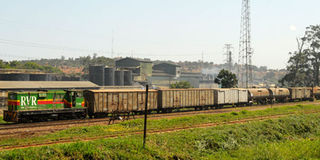Rail cargo movement increases in East Africa

Many businesspeople and companies in East African are now embracing rail transport because it is cost effective. FILE PHOTO
What you need to know:
According to the experts, rail transport does not only ease doing business in the region but also it is cost effective because of its turnaround, Dorothy Nakaweesi writes.
The East African Community member states’ appreciation of rail transport has increased, a trend experts think is good for doing business because it reduces on time.
This trend, according to the experts, does not only ease doing business in the region but also it is cost effective because of its turnaround.
Latest report from the Kenya Ports Authority (KPA) published this month shows that containers delivered up-country by rail from the Port of Mombasa recorded 671 twenty-foot equivalent unit (TEUs) registering an increase of 233 TEUs compared to the previous week.
Port operations performance during the week showed that a total of 11,189 TEUs (full and empty) were discharged from the ships and 10,049 TEUs loaded for export.
The total yard population registered 14,644 TEUs out of which 5,753 TEUS were awaiting pick up orders.
Uganda, Rwanda, DR Congo and South Sudan import and export their products through the port of Mombasa.
Imports population breakdown indicated that there were 3,170 TEUs locally bound (Kenya) and 4,873 TEUs for transit destinations.
Uganda bound containers recorded 3,825 TEUs, out of the 4,873 TEUs making it the biggest customer. This was followed by Tanzania bound containers that registered 444 TEUs, South Sudan with 233 TEUs, and Democratic Republic of Congo with 162 TEUs and Rwanda with 157 TEUs.
Reaction
Mr Daniel Birungi the executive director Uganda Manufacturers Association (UMA), says the reason Ugandans are taking up rail transport as an alternative is because it’s cost effective, especially to bulky importers.
“A case in point a trail carries 10 containers at ago while trucks can only carry five with all the attendants’ costs. This means rail provides better economies of scale than road transport,” Mr Birungi explains.
He, however, urged the relevant authorities to quickly sort out the issues of Uganda Railways Corporation and Rift Valley Railways.
Roofings Limited is one of the manufacturers who have taken advantage of rail transport because of the heavy products they import.
Speaking to Prosper Magazine, the company’s Business Development Manager, Mr Stuart Mwesigwa said: “We use more of rail on structural steel and hot rolled coil because they are heavy and voluminous. With railway we are able to carry over 400 tones compared to 24 tones when using road.”
Port operation
Through this port a total of 3,476 TEUs were ready for collection, 918 TEUs full exports (nominated/un-nominated), 740 TEUs transhipments, 2,887 TEUs empties and 870 TEUs at the Customs warehouse.
The Conventional cargo terminal received 22 general cargo vessels that discharged 285,348 metric tonnes and loaded another 4,265 metric tonnes for export. The terminal handled an average of 41,373metric tonnes per day with bulk clinker imports registering 96,029 metric tonnes.
Other cargoes included 83,793metric tonnes of bulk wheat imports, 45,266 metric tonnes of steel, 29,290 metric tonnes of bulk coal and 927 metric tonnes of project cargo. The cargo terminal received terminal also handled 1900 units of motorcars and 153 trucks.
Deliveries of general cargo by road transport recorded 240772metric tonnes while conveyor belt delivered another 44,576 metric tonnes .
Forecast for the next 14 days shows that 14 vessels were expected at the Container Terminals while the conventional cargo terminal expected 19 general cargo ships.
STATISTICS
Uganda bound containers recorded 3,825 TEUs, out of the 4,873 TEUs making it the biggest customer. This was followed by Tanzania bound containers that registered 444 TEUs, South Sudan with 233 TEUs, and Democratic Republic of Congo with 162 TEUs and Rwanda with 157 TEUs.
The Conventional cargo terminal received 22 general cargo vessels that discharged 285,348 metric tonnes and loaded another 4,265 metric tonnes for export. The terminal handled an average of 41,373metric tonnes per day with bulk clinker imports registering 96,029 metric tonnes.




